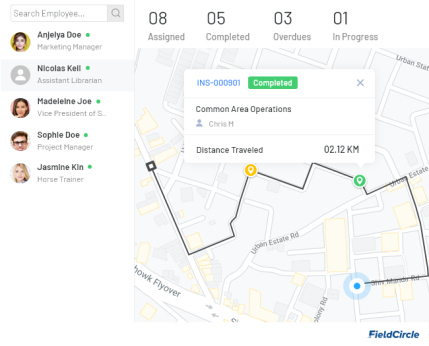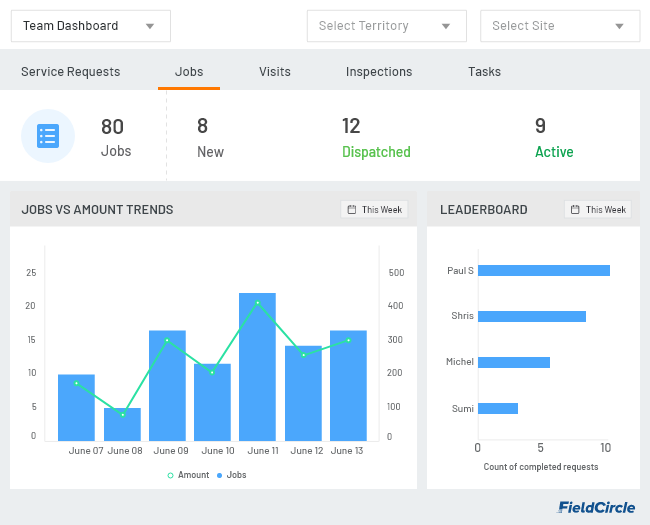Top 6 Ways You Can Reduce Field Service Operations Cost

Cost and quality maintain a very delicate balance in the field service industry.
Where every service call matters to the business, the fact that the high cost associated with every service delivered is detrimental to the quality of service delivered.
Does that mean field service management companies have to compromise on the quality of service in their attempt to reduce the cost?
What if customers are willing to pay for better-quality field service?
But then how would you know until you actually experience a demand for quality service even at the expense of increasing cost? We had built a field service software ROI calculator and our customers got some eye opening findings!
In order to answer these questions, you need visibility into your field service delivery process. You must be able to see the expenses that are chipping away at the profitability. You need information to analyze what-if scenarios to plug the leakages and optimize the service delivery process.
An attempt to reduce field service cost needs a surgical analysis of cost/performance ratio of every element in operations. For example, let us assume the key areas where you spend most of your money.
| Service Delivery | People | Infrastructure |
|---|---|---|
|
|
|
Now evaluate the cost vs. performance ratio of each element.
Take for example the cost associated with Travel.
The specific information that will help you perform a cost vs. performance analysis and lead you to the red flags is:
- No. of schedules in a day (new service call and follow-up)
- Total travel expenses in a day
- No. of resolved issues in a day
- No. of follow-ups trips
When you have such information in real-time, you can actually assess your service delivery process to find out what you are dealing with—an efficiency issue or under-priced service portfolio.
No. of issues resolved < No. of follow-up trips = Efficiency issue
No. of follow-up trips > No. of issues resolved = Pricing issue
Where, issues resolved indicates the actual task and the follow-up refers to the visits made by the field service technicians.
Over the years, we have seen following contributing significantly to reduced field service delivery costs. Hope it helps-
1. First-visit effectiveness statistics
If you find out that no. of follow-up trips of your team is relatively higher than the average no. of issues resolved in a day, it means your first-visit effectiveness is fairly low.
For example, the service resolution rate of 2 trips for each service request signals an alarming situation. So for say, if each trip costs you $50 extra (including the cost of resources) and your field service team makes 5 such trips a day, you still lose $250 every day.
Possible causes for low first-visit effectiveness are:

How can you address these issues?
Increasing first-visit effectiveness is a 3-step process.
Step 1. Know the problem and customer expectations in advance.
Step 2. Send a rightly skilled field service technician with appropriate equipment at the right time to resolve the issue in the first attempt.
Step 3. Follow a proper validation procedure to ensure that the task has been completed to the satisfaction of the customer.
If your field service team will follow these steps properly, they will automatically see an increase in first-visit effectiveness with a drop in no. of follow-up trips.
2. Is Your Scheduling Practice Up-to-date?
Travel has another related cost factor and that is scheduling.
Poor field service scheduling practices can increase internal conflicts in the team, which could dampen the spirit of field service technicians. In industries like painting and plumbing, for instance, scheduling inefficiencies come with a heavy cost.
Result—low productivity and high field service operations cost.
Let us take an example.
Mark has a work order at 11:00 AM and another at 4:00 PM. If he has to attend 5 service requests in a day, his schedules must be planned in a manner that:
- He gets a decent gap between every new trip to plan for the next trip. Nothing should be done haphazardly.
- He has access to information about clients, essential tools, and location in advance.
Don’t you think if the manager gets an exact detail of location and the ability to track and monitor the activity of the Mark, he could better arrange the timings.

Technologies could help probably. A report suggests that 89% of field service organizations want to apply modern technology in their technician scheduling system.
Here are some key benefits of leveraging a smart field service scheduling software for managing your scheduling and dispatching process.
- You can track the location of field technicians in real-time
- Match skills with task type before assigning a new task
- Assign new tasks nearest to their location
- Optimize routes to save fuel cost
This way, they can reduce their travel time, save costs incurred on traveling, and finish more jobs in a day.
A win-win situation for everyone—the client, the company, and the field technician.
3. Inventory Optimization
A study reveals that reducing overstock and stockouts can reduce the overall inventory management cost by 10%.
It seems the report made it quite clear what we need to do to reduce the field service costs.
But where to begin with?
To begin with, evaluate what you have in hand and then determine the requirements for improvements. Here are the questions that will help you understand the current inventory management condition.
Is stock-in and stock-out alerts shared in real time?
Can you keep track of current stock, dead stock, frequently used tools and rarely used tools?
Does every member of the team have access to inventory-related information?
If you have such information in hand, the road ahead to inventory optimization is easy. Just re-examine your service levels and manage your inventory size and dead stock based on the information.
In case you lack such information, first thing you need to do is to get your hands on inventory management tools that provide real-time status of the inventory.
These tools can provide you with visibility essential for improving your inventory management and cash flow. You can:
- Effectively plan replenishments based on urgent and future requirements.
- Schedule field service technician only when the right tool is available.
- Save on storage cost, reduce heavy investment in not-critical requirements, and manage relationships with suppliers.
Surely, following these tips will help you reduce your field service cost and simultaneously optimize inventory operations.
4. Go Digital
According to a report , 52% organizations still use manual methods for field services.
Manual methods for field service delivery are neither cost-effective nor efficient.
See, information is collected from a variety of sources throughout the field service delivery process. If you have hired people to collect and report the information, it is time to switch to automated methods.
Using digital tools such as field service management software for services ops, or an inspection software, you can collect a variety of information such as work order details or inspection reports, e-sign off by customers, invoices, warranty and contracts, attendance and leaves of the employees and so on, so that your employees can work more efficiently.
Efficient employees, more work, less cost.
Review your entire field service management lifecycle and identify the processes that are redundant or extensively dependent on paper.
Check the cost associated with the people managing those processes and then plan on automating those processes so that you can effectively minimize all the middlemen and associated cost.
5. Save Cost on Recruitment and Training
Who is your rockstar field service representative?
How well his efforts are recognized and rewarded that the rep feels motivated to give his best shot every time?
As the talent war is looming in the field service industry, retaining your best talent is an effective method to save costs on hiring and training. However, the recognition should be data-driven and must not be influenced by any biases. As in a Harris Interactive Research survey, 41% of respondents said that the cost of bad hire was greater than $25,000.
Create a performance profile of your field service team by tracking:
- No. of call made by the field service representative
- No. of work orders assigned in a day
- No. of work orders completed in a day
- Type and current status of the task assigned
- Inspection and validation of the task
Set metrics and evaluate the performance profile of each field service technician and determine the compensation and rewards based on the metrics achieved. You may find this post on the top field service metrics leaders track helpful.
6. Get Real-time Business Information
Having real-time information about your business will strengthen your decision-making capabilities.
The information varies from individual field technicians to the overall performance of your business in a specific timeframe.

For instance, if you have the knowledge of:
- The areas where you are getting most of your business?
- Where does your field service technician spend most and least of their time?
- How does your field service technician respond to customer queries?
- How long do they take to complete a task?
You will be able to bring on incremental change in the field service delivery process, essential for reducing field service operations costs.
Putting it all together
If you are far behind on your bills, these are some ways you can cut on expenses and direct the flow of your business earnings to a leaner, automated, and error-free process.
Also, as a field service business is usually location-specific and to bring in more revenue to your business, you should think to invest in increasing your business outreach.
Take the help of tools to complete the work orders of a larger market, keep information about your business at your fingertips, and take more bold, effective, and data-driven decisions by leveraging the power of data visualization to uncover insights and trends that drive smarter actions.
Learn how FieldCircle can help you reduce field service delivery costs by 15% and overall field service operations cost by 25%.


